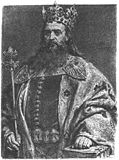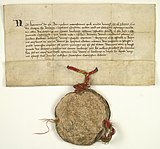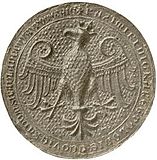Casimir III the Great
Last updated| Casimir III the Great | |
|---|---|
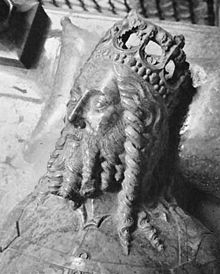 Casimir's tomb effigy in Wawel | |
| King of Poland | |
| Reign | 1333–1370 |
| Coronation | 25 April 1333 |
| Predecessor | Ladislaus the Short |
| Successor | Louis I of Hungary |
| King of Ruthenia | |
| Reign | 1340–1370 |
| Predecessor | Yuri II of Galicia |
| Successor | Louis I of Hungary |
| Born | 30 April 1310 Kowal, Duchy of Brześć Kujawski |
| Died | 5 November 1370 (aged 60) Kraków, Poland |
| Burial | Wawel Cathedral, Kraków |
| Spouse | Aldona of Lithuania Adelaide of Hesse Christina Rokiczana (morganatic) Hedwig of Sagan |
| Issue more... | Elisabeth, Duchess of Pomerania Anna, Countess of Cilli |
| House | Piast |
| Father | Władysław I Łokietek |
| Mother | Jadwiga of Kalisz |
| Religion | Roman Catholic |
| Signature |  |
Casimir III the Great (Polish : Kazimierz III Wielki; 30 April 1310 – 5 November 1370) reigned as the King of Poland from 1333 to 1370. He also later became King of Ruthenia in 1340, and fought to retain the title in the Galicia-Volhynia Wars. He was the last Polish king from the Piast dynasty.
Contents
- The Great King
- Reforms
- Politics and expansion
- Succession
- Society under the reign of Casimir
- Relationship with Jews
- Relationships and children
- Aldona of Lithuania
- Adelaide of Hesse
- Christina Rokiczana
- Hedwig of Żagań
- Title and style
- Popular culture
- Film
- Video games
- Currency
- Gallery
- See also
- Notes
- References
- Source
- External links
Casimir inherited a kingdom weakened by war and made it prosperous and wealthy. He reformed the Polish army and doubled the size of the kingdom. He reformed the judicial system and introduced a legal code, gaining the title "the Polish Justinian". [1] Casimir built extensively and founded the Jagiellonian University (back then simply called the University of Krakow), [2] the oldest Polish university and one of the oldest in the world. He also confirmed privileges and protections previously granted to Jews and encouraged them to settle in Poland in great numbers. [3]
Casimir left no legitimate sons. When he died in 1370 from an injury received while hunting, his nephew, King Louis I of Hungary, succeeded him as king of Poland in personal union with Hungary.
The Great King

Casimir was born on 30 April 1310 in Kowal, Kuyavia, [4] the third son of Ladislaus the Short and Jadwiga of Kalisz. [5] He had two brothers who died in infancy and three sisters: Kunegunda, Elżbieta, and Jadwiga. [4] When Casimir attained the throne in 1333, his position was in danger, as his neighbours did not recognise his title and instead called him "king of Kraków". The kingdom was depopulated and exhausted by war, and the economy was ruined. In 1335, in the Treaty of Trentschin, Casimir was forced to relinquish his claims to Silesia "in perpetuity".
Casimir began to rebuild the country and strengthen its defenses. During his reign, nearly 30 towns were supplied with fortification walls and some 50 castles were constructed, including castles along the Trail of the Eagle's Nests. These achievements are still celebrated today, in a commonly-known ditty that translates as follows: inherited wooden towns and left them fortified with stone and brick (Kazimierz Wielki zastał Polskę drewnianą, a zostawił murowaną). [6]
He organized a meeting of kings in Kraków in 1364 at which he exhibited the wealth of the Polish kingdom. [7] Casimir is the only king in Polish history to both receive and retain the title of "Great", as Bolesław I is more commonly known as "the Brave". [8]
Reforms
Casimir ensured stability and great prospects for the future of the country. He established the Corona Regni Poloniae – the Crown of the Polish Kingdom, [6] which certified the existence of the Polish lands independently from the monarch. Prior to that, the lands were only the property of the Piast dynasty.
At the Sejm in Wiślica, on 11 March 1347, Casimir introduced reforms to the Polish judicial system and sanctioned civil and criminal codes for Great and Lesser Poland, earning the title "the Polish Justinian". [1] In 1364, having received permission from Pope Urban V, Casimir established the University of Kraków, now the oldest university in Poland. [9] It was regarded as a rare distinction, since it was only the second university founded in Central Europe, after the Charles University in Prague. [6]
Politics and expansion
Casimir demonstrated competence in foreign diplomacy and managed to double the size of his kingdom. He neutralized relations with potential enemies to the west and north, and began to expand his territory eastward. He conquered the Ruthenian kingdom of Halych and Volodymyr (a territory in the modern-day Ukraine), known in Polish history as Red Ruthenia and Volhynia. By extending the borders far south-east, the Polish kingdom gained access to the lucrative Black Sea trade. [10]
Succession
In 1355, in Buda, Casimir designated his nephew Louis I of Hungary as his successor should he produce no male heir, just as his father had with Charles I of Hungary to gain help against Bohemia. In exchange Casimir gained a favourable Hungarian attitude, needed in disputes with the hostile Teutonic Order and the Kingdom of Bohemia. At the time Casimir was 45 years old, and so producing a son did not seem unreasonable. [11]
Casimir left no legal son, however, begetting five daughters instead. He tried to adopt his grandson, Casimir IV, Duke of Pomerania, in his last will. The child had been born to his eldest daughter, Elisabeth, Duchess of Pomerania, in 1351. This part of the testament was invalidated by Louis I of Hungary, however, who had traveled to Kraków quickly after Casimir died (in 1370) and bribed the nobles with future privileges. Casimir III also had a son-in-law, Louis VI of Bavaria, Margrave and Prince-elector of Brandenburg, who was considered a possible successor, but he was deemed ineligible as his wife, Casimir's daughter Cunigunde, had died in 1357 without issue. [12]
Thus King Louis I of Hungary became successor in Poland. Louis was proclaimed king upon Casimir's death in 1370, though Casimir's sister Elisabeth (Louis's mother) held much of the real power until her death in 1380. [13]
Society under the reign of Casimir
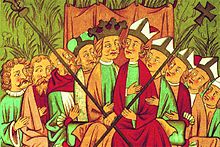
Casimir was facetiously named "the Peasants' King". He introduced the codes of law of Greater and Lesser Poland as an attempt to end the overwhelming superiority of the nobility. During his reign all three major classes — the nobility, priesthood, and bourgeoisie — were more or less counterbalanced, allowing Casimir to strengthen his monarchic position. He was known for siding with the weak when the law did not protect them from nobles and clergymen. He reportedly even supported a peasant whose house had been demolished by his own mistress, after she had ordered it to be pulled down because it disturbed her enjoyment of the beautiful landscape.[ citation needed ]
His popularity with the peasants helped to rebuild the country, as part of the reconstruction program was funded by a land tax paid by the lower social class. [6]
Relationship with Jews

On 9 October 1334, Casimir confirmed the privileges granted to Jews in 1264 by Bolesław V the Chaste. Under penalty of death, he prohibited the kidnapping of Jewish children for the purpose of enforced Christian baptism, and he inflicted heavy punishment for the desecration of Jewish cemeteries. While Jews had lived in Poland since before his reign, Casimir allowed them to settle in Poland in great numbers and protected them as people of the king. About 70 percent of the world's European Jews, or Ashkenazi, can trace their ancestry to Poland due to Casimir's reforms. [14] Casimir's legendary Jewish mistress Esterka remains unconfirmed by direct historical evidence. [15]
Relationships and children
Casimir III was married four times:
Aldona of Lithuania
On 30 April or 16 October 1325, Casimir married Aldona of Lithuania, [lower-alpha 1] [17] daughter of Grand Duke Gediminas of Lithuania [18] and Jewna. They had:
- Elisabeth of Poland (ca. 1326–1361); married Duke Bogislaus V of Pomerania [19]
- Cunigunde of Poland (1334–1357), [19] married Louis VI the Roman, the son of Louis IV, Holy Roman Emperor
- Anna [19]
Aldona died on 26 May 1339. Casimir remained a widower for two years.
Adelaide of Hesse
On 29 September 1341, Casimir married his second wife, Adelaide of Hesse. She was a daughter of Henry II, Landgrave of Hesse, and Elizabeth of Meissen. They had no children. Casimir started living separately from Adelaide soon after the marriage. Their loveless marriage lasted until 1356, when he declared himself divorced. [20]
Christina Rokiczana
After Casimir "divorced" Adelaide he married his mistress Christina Rokiczana, the widow of Miklusz Rokiczani, a wealthy merchant. Her own origins are unknown. Following the death of her first husband she had entered the court of Bohemia in Prague as a lady-in-waiting. Casimir brought her with him from Prague and convinced the abbot of the Benedictine abbey of Tyniec to marry them. The marriage was held in a secret ceremony but soon became known. Queen Adelaide renounced it as bigamous and returned to Hesse. Casimir continued living with Christine despite complaints by Pope Innocent VI on behalf of Queen Adelaide. This marriage lasted until 1363–64 when Casimir again declared himself divorced. They had no children. [21]
Hedwig of Żagań
In about 1365, Casimir married his fourth wife Hedwig of Żagań. She was a daughter of Henry V of Iron, Duke of Żagań and Anna of Mazovia. They had three children:
- Anna of Poland, Countess of Celje (1366 – 9 June 1422); married firstly William of Celje; their only daughter was Anne of Celje, who married Jogaila of Lithuania when he was king of Poland (as Władysław II Jagiełło). Anna married secondly Ulrich, Duke of Teck; they had no children.
- Kunigunde of Poland (1367 – 1370)
- Jadwiga of Poland (1368 – ca. 1382)
As Adelheid was still alive (and possibly Christina as well), the marriage to Hedwig was also considered bigamous. Because of this, the legitimacy of his three young daughters was disputed. [22] Casimir managed to have Anna and Kunigunde legitimated by Pope Urban V on 5 December 1369. Jadwiga the younger was legitimated by Pope Gregory XI on 11 October 1371 (after Casimir's death). [23]
Title and style
Casimir's full title was: Casimir by the grace of God king of Poland and Rus' (Ruthenia), lord and heir of the land of Kraków, Sandomierz, Sieradz, Łęczyca, Kuyavia, Pomerania (Pomerelia) . The title in Latin was: Kazimirus, Dei gratia rex Polonie et Russie, nec non Cracovie, Sandomirie, Siradie, Lancicie, Cuiavie, et Pomeranieque Terrarum et Ducatuum Dominus et Heres. [24]
Popular culture
Film
- Casimir III the Great is one of the main characters in Polish historical drama series Korona królów (The Crown of the Kings). He is played by Mateusz Król (season 1) and Andrzej Hausner (season 2). [25]
- Casimir III the Great is mentioned in a speech by Amon Göth in the film Schindler's List . [26]
Video games
- Casimir features as a playable leader in the 2010 strategy game Civilization V , having been added in its 2013 expansion, Brave New World.
- Casimir also features as a ruler in the strategy game Crusader Kings II .
Currency
- Casimir is featured on the obverse of the 50 Polish złoty banknote, with his regalia on the reverse. [27]
Gallery
- Casimir III the Great by Jan Matejko
- Casimir the Great by Leopold Loeffler
- Casimir III's tomb at Wawel Cathedral
- Document issued by Casimir the Great granting the Armenian bishop Gregory (Գրիգոր) the right to stay and preach in Lviv, 1367
- Royal seal, 1334
See also
Notes
Related Research Articles

Jadwiga, also known as Hedwig, was the first woman to be crowned as monarch of the Kingdom of Poland. She reigned from 16 October 1384 until her death. She was the youngest daughter of Louis the Great, King of Hungary and Poland, and his wife, Elizabeth of Bosnia. Jadwiga was a member of the Capetian House of Anjou, but she had more close forebears among the Polish Piasts than among the Angevins.

Casimir IV was Grand Duke of Lithuania from 1440 and King of Poland from 1447 until his death in 1492. He was one of the most active Polish-Lithuanian rulers; under him, Poland defeated the Teutonic Knights in the Thirteen Years' War and recovered Pomerania.
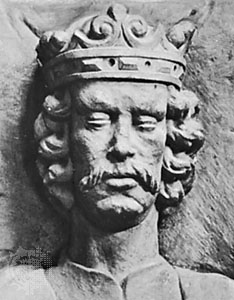
Władysław I Łokietek, in English known as the "Elbow-high" or Ladislaus the Short, was King of Poland from 1320 to 1333, and duke of several of the provinces and principalities in the preceding years. He was a member of the royal Piast dynasty, the son of Duke Casimir I of Kuyavia, and great-grandson of High-Duke Casimir II the Just.
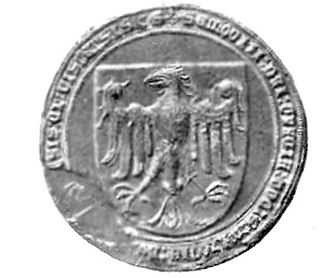
Siemowit IV, also known as Siemowit IV the Younger, was a Polish prince member of the House of Piast from the Masovian branch, from 1373/74 Duke of Rawa, and after the division of the paternal inheritance between him and his brother in 1381, ruler over Rawa, Płock, Sochaczew, Gostynin, Płońsk and Wizna, since 1386 hereditary Polish vassal, since 1388 ruler over Belz, during 1382–1401 he lost Wizna and during 1384–1399 and 1407–1411 he lost Zawkrze, during 1384–1399 he lost Płońsk, taken by the Teutonic Order.

Siemowit III of Masovia was a prince of Masovia and a co-regent of the lands of Warsaw, Czersk, Rawa, Gostynin and other parts of Masovia.

The Capetian House of Anjou, or House of Anjou-Sicily, was a royal house and cadet branch of the direct French House of Capet, part of the Capetian dynasty. It is one of three separate royal houses referred to as Angevin, meaning "from Anjou" in France. Founded by Charles I of Anjou, the youngest son of Louis VIII of France, the Capetian king first ruled the Kingdom of Sicily during the 13th century. The War of the Sicilian Vespers later forced him out of the island of Sicily, which left him with the southern half of the Italian Peninsula, the Kingdom of Naples. The house and its various branches would go on to influence much of the history of Southern and Central Europe during the Middle Ages until it became extinct in 1435.
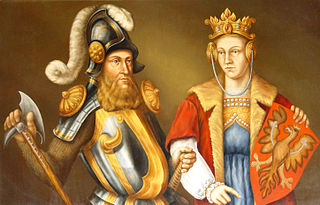
Bogislaw V, sometimes known as the Great, was a Duke of Pomerania.

Esterka (Estera) refers to a mythical Jewish mistress of Casimir the Great, the historical King of Poland who reigned between 1333 and 1370. Medieval Polish and Jewish chroniclers considered the legend as historical fact and report a wonderful love story between the beautiful Jewess and the great monarch.
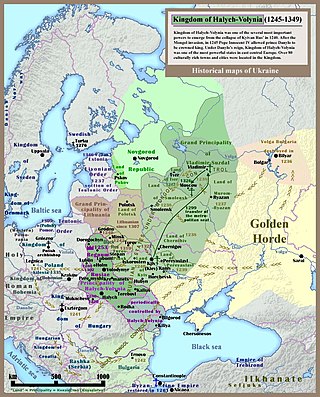
The Galicia–Volhynia Wars were several wars fought in the years 1340–1392 over the succession in the Kingdom of Galicia–Volhynia, also known as Ruthenia. After Yuri II Boleslav was poisoned by local Ruthenian nobles in 1340, both the Grand Duchy of Lithuania and the Kingdom of Poland advanced claims over the kingdom. After a prolonged conflict, Galicia–Volhynia was partitioned between Poland (Galicia) and Lithuania (Volhynia) and Ruthenia ceased to exist as an independent state. Poland acquired a territory of approximately 52,000 square kilometres (20,000 sq mi) with 200,000 inhabitants.
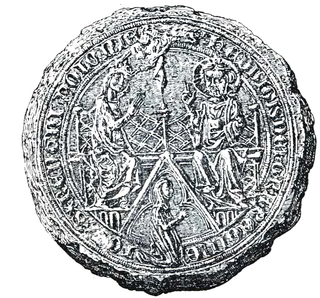
Jadwiga of Kalisz was a Queen of Poland by marriage to Ladislaus the Short. She was the mother of the last Piast King of Poland, Casimir III.

Adelaide of Hesse was queen consort of Poland by marriage to Casimir III of Poland. She was daughter of Henry II, Landgrave of Hesse, and his wife Elisabeth of Thuringia, daughter of Frederick I, Margrave of Meissen. Adelaide was a member of the House of Hesse.
Hedwig of Sagan was Queen of Poland as the fourth wife of Casimir III. Casimir's lack of male heir spelled the end of the Piast Dynasty in the Kingdom of Poland. After Casimir's death in 1370, she remarried Rupert I of Legnica.

Dymitr of Goraj (c.1340–1400) of Clan Korczak was a Grand Crown Marshal from 1390 and Court Treasurer in the years 1364–1370 and 1377–1391. He was one of the wealthiest magnates of his era, and a mentor and adviser to Queen Jadwiga of Poland.

The period of rule by the Piast dynasty between the 10th and 14th centuries is the first major stage of the history of the Polish state. The dynasty was founded by a series of dukes listed by the chronicler Gall Anonymous in the early 12th century: Siemowit, Lestek and Siemomysł. It was Mieszko I, the son of Siemomysł, who is now considered the proper founder of the Polish state at about 960 AD. The ruling house then remained in power in the Polish lands until 1370. Mieszko converted to Christianity of the Western Latin Church in an event known as the Baptism of Poland in 966, which established a major cultural boundary in Europe based on religion. He also completed a unification of the Lechitic tribal lands that was fundamental to the existence of the new country of Poland.

The Jagiellonian or Jagellonian dynasty, otherwise the Jagiellon dynasty, the House of Jagiellon, or simply the Jagiellons, was the name assumed by a cadet branch of the Lithuanian ducal dynasty of Gediminids upon reception by Jogaila, the Grand Duke of Lithuania, of baptism as Władysław in 1386, which paved the way to his ensuing marriage to the Queen Regnant Jadwiga of Poland, resulting in his ascension to the Crown of the Kingdom of Poland as Władysław II Jagiełło, and the effective promotion of his branch to a royal dynasty. The Jagiellons reigned in several European countries between the 14th and 16th centuries. Members of the dynasty were Kings of Poland (1386–1572), Grand Dukes of Lithuania, Kings of Hungary, and Kings of Bohemia and imperial electors (1471–1526).

Personal union between the Kingdom of Hungary and the Kingdom of Poland was achieved twice: under Louis I of Hungary, in 1370–1382, and under Władysław III of Poland in 1440–1444. An earlier union was also accomplished by Wenceslaus III of Bohemia for a few months in 1305, although he was heavily resisted by local nobles in both kingdoms, and gave up the Hungarian crown soon after.
Korona królów is a Polish historical drama series. Aired from January 1, 2018, on TVP1. The show is a biographical story about the reign of: King Casimir III the Great, Queen Jadwiga and King Władysław II Jagiełło as co-rulers, and then Jagiełło as the sole ruler of the Kingdom of Poland. The series tells the story of the monarchy in Poland in the 14th and 15th century.
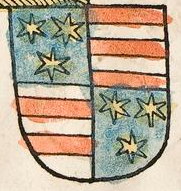
William of Celje, also William of Cilli, Count of Celje, was a Styrian nobleman who was married to Anna of Poland, daughter of the Polish king Casimir the Great. He was the co-ruler of the House of Celje together with his uncle Hermann I until 1385 and then with his cousin Hermann II until his death. William's only daughter, Anna of Celje, married the Polish King Vladislav II Jagello in order to strengthen his claim to the Polish throne.

The Duchy of Gniewkowo was a district principality and a fiefdom within the Kingdom of Poland during the era of fragmentation that was formed in 1314 from part of the Duchy of Inowrocław. The country was located in the Kuyavia and consisted of Gniewkowo and Słońsk Lands. Its capital was Gniewkowo and other important settlements were Szarlej, Złotoria and Słońsk. It was ruled by Kazimierz III of Gniewkowo and later his son, Władysław the White, from the Piast dynasty. In 1332 the duchy was conquered by the State of the Teutonic Order and was reestablished in 1343. Between 1363 and 1364, the duchy was incorporated into the Kingdom of Poland. Duke of Gniewkowo, Władysław the White, had later briefly re-established the duchy in the rebellion fought between 1373 and 1374 and later between 1375 and 1377, and eventually given up his claims to the land in 1377.
References
- 1 2 Saxton, L. C. (1851). Fall of Poland; containing an analytical and a philosophical account of the causes which conspired in the ruin of that nation; together with a history of the country from its origin, in two volumes. Vol. I. New York: Charles Scribner publishing company. pp. 89.
- ↑ Saxton, 1851, p. 535
- ↑ Aharoni, Yohanan (2006-09-15). The Jewish People: An Illustrated History. A&C Black. p. 220. ISBN 978-0-8264-1886-9.
- 1 2 "Kazimierz III Wielki (1310–1370)" . Retrieved 28 March 2020.
- ↑ Lerski 1996, p. 249–250.
- 1 2 3 4 Dobrawski, Patrice M. (2016). Poland: The First Thousand Years. Illinois: Northern Illinois University Press. p. 37. ISBN 978-0-87580-756-0.
- ↑ Nowakowska, Natalia (2007). Church, State and Dynasty in Renaissance Poland: The Career of Cardinal Fryderyk Jagiellon (1468-1503). Ashgate Publishing, Ltd. p. 13. ISBN 9780754656449.
- ↑ "Czy Kazimierz Wielki zasłużenie nosi przydomek "wielki"? Argumenty za" . Retrieved 29 March 2020.
- ↑ Ness, Daniel; Lin, Chia-Ling (2015). International Education: An Encyclopedia of Contemporary Issues and Systems. Routledge. p. 569. ISBN 9781317467519.
- ↑ Dobrawski, Partice M. (2016). Poland: The First Thousand Years. Illinois: Northern Illinois University Press. p. 35. ISBN 978-0-87580-756-0.
- ↑ "Władca, który zasłużył na swój przydomek. Dziś rocznica śmierci Kazimierza Wielkiego" . Retrieved 28 March 2020.
- ↑ "Kunegunda, córka Kazimierza Wielkiego: nieszczęśliwa panna młoda" . Retrieved 29 March 2020.
- ↑ Lukowski, Jerzy; Zawadzki, Hubert (2016) [2001]. A concise history of Poland . Cambridge University Press. pp. 34. ISBN 9780521853323.
- ↑ "In Poland, a Jewish Revival Thrives—Minus Jews". The New York Times . 12 July 2007.
- ↑ "Esterka: między legendą a prawdą historyczną" . Retrieved 28 March 2020.
- ↑ Rowell 1994, p. 232.
- ↑ Frost 2015, p. 28.
- ↑ Rowell 1994, p. 91-92.
- 1 2 3 Davies 1982, p. 65.
- ↑ Rhode, Gotthold K.S. "Casimir III". Encyclopædia Britannica. Encyclopædia Britannica, inc. Retrieved April 12, 2018.
- ↑ "Krystyna Rokiczana. Romans Kazimierza z piękną Czeszką zakończony bigamicznym małżeństwem" . Retrieved 28 March 2020.
- ↑ "Nieszczęśliwy małżonek. Kazimierz Wielki – bigamista do kwadratu" . Retrieved 28 March 2020.
- ↑ Pope Gregory XI: the Failure of Tradition ISBN 978-0-819-15463-7 p. 119
- ↑ Document Nr 1340 (CODEX DIPLOMATICUS MAIORIS POLONIA). POZNANIAE. SUMPTIBUS BIBLIOTHECAE KORNICENSIS. TYPIS J. I. KRASZEWSKI (Dr. W. ŁEBIŃSKI). 1879.
- ↑ "PEŁNA OBSADA I TWÓRCY" . Retrieved 29 March 2020.
- ↑ "SCHINDLER'S LIST SCRIPT" (PDF). Retrieved 29 March 2020.
- ↑
